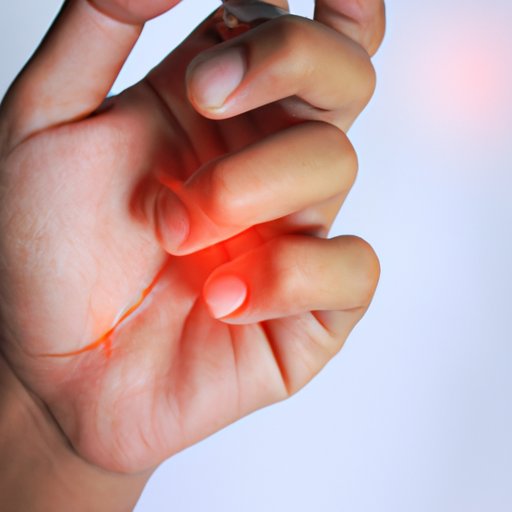
Introduction
If you’ve ever experienced a finger injury, you know how painful and inconvenient it can be. While fingers are small parts of our body, they play a vital role in performing everyday tasks such as typing, writing, cooking, and even communicating with hand gestures. Fractures in the finger can occur due to various reasons, and it’s important to identify the signs and take appropriate measures to prevent further damage. So, in this article, we will discuss how to know if you broke your finger and what to do about it.
Signs and Symptoms of Finger Fracture
Fractures can happen in any of the fingers, including the thumb. Here are some common signs and symptoms of finger fractures:
Swelling, Bruising, or Discoloration
One of the most apparent symptoms of a broken finger is swelling, bruising, or discoloration of the affected area. The finger may also look misaligned or bent in an abnormal position.
Pain or Tenderness
Fractured fingers can cause significant pain and tenderness, especially while trying to move the affected area. This pain can be felt around the broken bone or the joint, depending on the type and location of the fracture.
Deformity or Misshapen Appearance
In some cases, the affected finger may look deformed or have a misshapen appearance. This is often due to a displaced bone or a fracture involving multiple pieces. In such cases, the finger may be visibly crooked or sticking out at an odd angle.
Difficulty Moving the Finger
A broken finger can make it challenging to move the affected finger or grip objects. It can also cause stiffness and restriction of movement in the adjacent fingers due to swelling or pain.
Causes of Finger Fracture
There are several ways you can break your finger:
Common Injuries
The most common type of finger fracture occurs due to injuries such as falling on an outstretched hand, jamming the finger, bending fingers in an improper way, or hitting the finger against a hard surface. These injuries can cause bone fractures, joint dislocations, or ligament damages.
Tips to Prevent Finger Fractures
You can take some simple steps to prevent finger fractures, such as practicing proper hand hygiene, doing warm-up and stretching exercises before any physical activities, wearing protective gloves or gear while engaging in risky sports or tasks, and avoiding repetitive manual operations.
First Aid and Treatment of Finger Fracture
If you’ve broken your finger, here are some steps you can take:
Steps to Perform Immediate First Aid
The first thing to do after breaking your finger is to seek medical attention. Meanwhile, you can perform first aid by immobilizing the finger using a splint, a sling, or a folded piece of cloth. Apply ice packs on the affected area to manage swelling and pain. Do not attempt to rotate or pull the finger, as this can worsen the injury and cause nerve damage.
Treatment Options
Treatment for a broken finger depends on the type, severity, and location of the fracture. Minor fractures can be treated using nonsurgical methods such as cast or splint, therapy, or medication. More severe cases may require surgery, including resetting and stabilizing the broken bone with pins, screws, or plates.
Healing Time and Recovery Process
The healing time for a broken finger can vary from a few weeks to several months, depending on the nature and extent of the injury. After the initial treatment, you might need to undergo rehabilitation therapy to restore strength, flexibility, and movement to the affected finger. This can involve exercises, stretching, and massage techniques guided by a professional physiotherapist.
Comparison of Broken and Sprained Fingers
It’s crucial to differentiate between a broken finger and a sprained finger, as the two require different treatments. Here are some differences to keep in mind:
How to Identify Them
A broken finger usually causes visible symptoms like swelling, bruising, or deformity, while a sprained finger may show minimal signs of damage. You may experience mild swelling or stiffness in a sprained finger, but it could still move with some discomfort.
Treatments for Broken and Sprained Fingers
A broken finger typically requires more extensive and specific treatment than a sprained one. A sprained finger can be usually treated with the RICE method (rest, ice, compress, and elevate), while more severe or complicated sprains might require a cast or a brace. However, broken fingers typically need splints, casts, or surgery depending on the severity of the break.
Tips to Prevent Both Injuries
To prevent both injuries, you can practice proper hand hygiene, do appropriate stretching and warmup exercises before any activities, avoid risky or strenuous tasks, and wear protective gloves or gear to absorb the impact of falls or other injuries.
Expert Advice on Finger Injuries
We talked to a sports physician, Dr. John, who has experience treating hand and finger injuries. Here are some insights from him:
Typical Nature of Finger Injuries and Recovery
“Finger injuries are relatively common, especially among athletes and active individuals. Depending on the type of injury and its severity, recovery time can vary. However, following proper treatment and rehabilitation, most individuals can gradually regain their function and return to their normal activities.”
Role of Physiotherapy in Healing Broken Fingers
“Physiotherapy plays a vital role in the recovery of broken fingers. It helps to restore joint function, flexibility, strength, and movement. Your physiotherapist can guide you through various exercises and treatments that would facilitate healing and prevent any long-term complications.”
Conclusion
In summary, a broken finger can cause severe pain and discomfort, but prompt diagnosis and treatment can prevent further damage and hasten recovery. You should seek medical attention if you experience any signs or symptoms of a finger fracture and avoid any sudden movements that could exacerbate the injury. Remember to take preventive measures like proper hand hygiene, stretching, and the use of protective gear to minimize the risk of finger fractures in the future.





